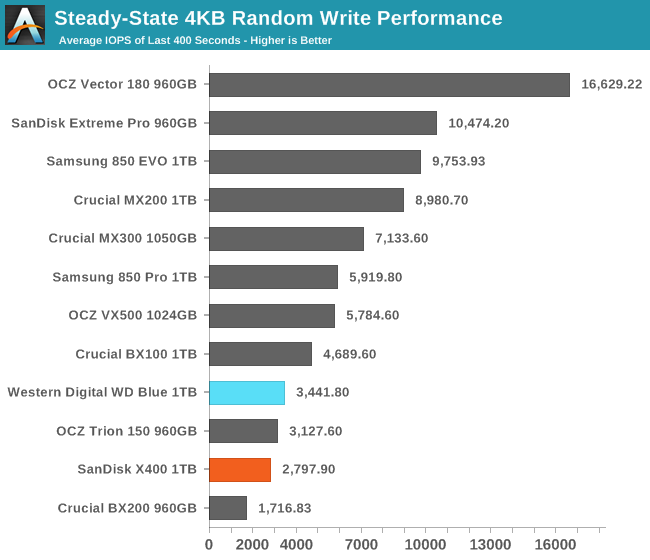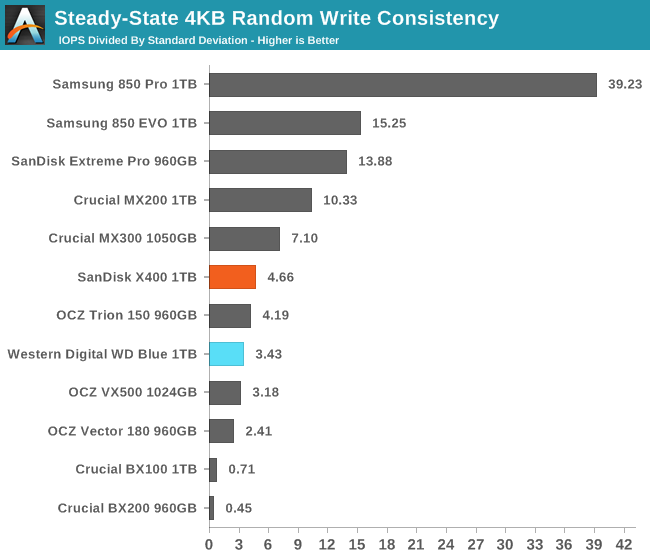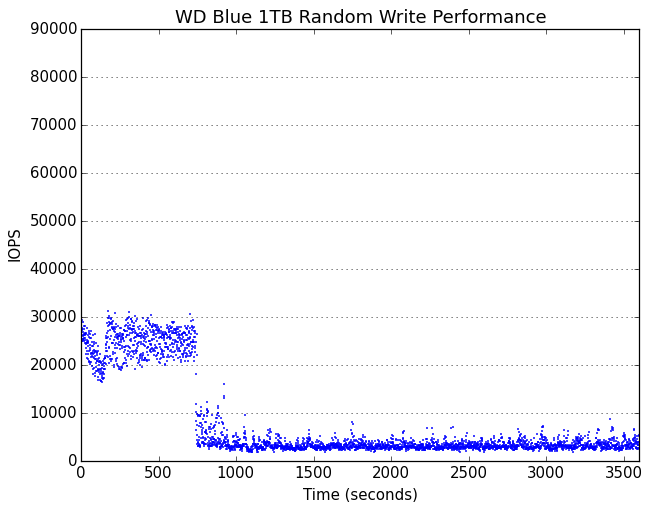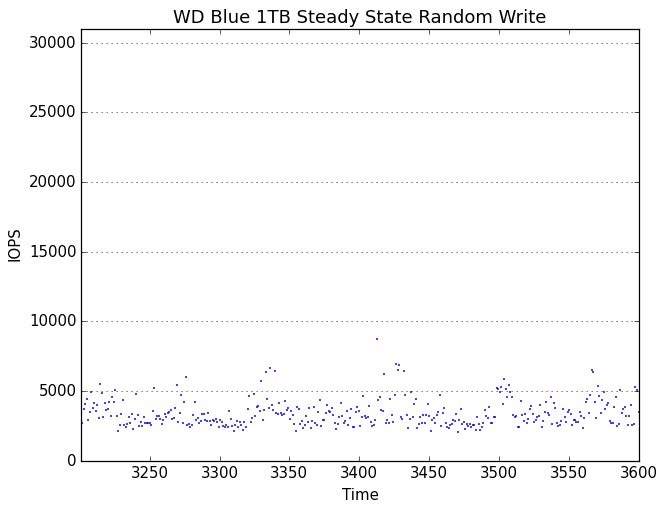The Western Digital Blue (1TB) SSD Review: WD Returns to SSDs
by Billy Tallis on October 11, 2016 8:00 AM EST- Posted in
- SSDs
- Storage
- Western Digital
- SanDisk
Performance Consistency
Our performance consistency test explores the extent to which a drive can reliably sustain performance during a long-duration random write test. Specifications for consumer drives typically list peak performance numbers only attainable in ideal conditions. The performance in a worst-case scenario can be drastically different as over the course of a long test drives can run out of spare area, have to start performing garbage collection, and sometimes even reach power or thermal limits.
In addition to an overall decline in performance, a long test can show patterns in how performance varies on shorter timescales. Some drives will exhibit very little variance in performance from second to second, while others will show massive drops in performance during each garbage collection cycle but otherwise maintain good performance, and others show constantly wide variance. If a drive periodically slows to hard drive levels of performance, it may feel slow to use even if its overall average performance is very high.
To maximally stress the drive's controller and force it to perform garbage collection and wear leveling, this test conducts 4kB random writes with a queue depth of 32. The drive is filled before the start of the test, and the test duration is one hour. Any spare area will be exhausted early in the test and by the end of the hour even the largest drives with the most overprovisioning will have reached a steady state. We use the last 400 seconds of the test to score the drive both on steady-state average writes per second and on its performance divided by the standard deviation.

With a slight increase in out of the box overprovisioning, it is unsurprising to see the WD Blue improve on the SanDisk X400's steady-state random write performance. The WD Blue overtakes the OCZ Trion 150 as the fastest planar TLC NAND SSD, but doesn't catch up to the MLC or 3D TLC drives.

The WD Blue has slightly worse performance consistency than the X400, but not low enough to be cause for concern.
 |
|||||||||
| Default | |||||||||
| 25% Over-Provisioning | |||||||||
Before reaching steady state, the WD Blue hovers between 20k and 30k IOPS, a significant improvement over the X400. Several other competitors have higher peak performance, but are either less consistent during the early phase of the test or don't last as long before dropping to steady state.
 |
|||||||||
| Default | |||||||||
| 25% Over-Provisioning | |||||||||
Upon reaching steady state, the WD Blue varies from roughly 2500 IOPS to 5000 IOPS, with short bursts of slightly higher performance. With extra overprovisioning the base performance of the WD Blue doesn't change but the upper limit of its normal band of performance increases to around 10k IOPS and the peaks reach 25k.










75 Comments
View All Comments
Magichands8 - Wednesday, October 12, 2016 - link
That's funny you should say that since I've been noticing it for years. Every single time I move around large files to reorganize or back them up, in fact. But I'm sure that I'm the only non-video editing person on the planet who doesn't use his computer exclusively for reading and writing tiny text files and browsing the internet. I'm also sure that I'm the only who would have a problem paying a premium for very low capacity devices just so I could experience their limitations.Michael Bay - Thursday, October 13, 2016 - link
Oy vey, nobody in the market cares for my special snowflake wants, it`s anudda shoah!mapesdhs - Friday, October 14, 2016 - link
You need more explosions in your posts. ;Dbeginner99 - Wednesday, October 12, 2016 - link
It's cheap but not really excitingly cheap. Doesn't really beat the aged MX200 which also comes with MLC NAND which I deem superior to this TLC low-end crap. Only advantage this has over MX200 is price. Good for a cheapo game-drive maybe but would avoid as OS drive.Arnulf - Wednesday, October 12, 2016 - link
Ewww, 15nm planar TLC along with WD branding.JimmiG - Wednesday, October 12, 2016 - link
I remember the time when the 850 Evo was considered a "budget" SSD. Now it's almost a high-end SSD.haukionkannel - Wednesday, October 12, 2016 - link
And the price of evo is still going up. Hopefully there will be stop to it eventually.Impulses - Wednesday, October 12, 2016 - link
It's not really going up, just plateau'ing hard, sales might be happening slightly less frequently lately, I dunno... I do remember seeing the 1TB under $300 a number of times but it's mostly been just over $300 for well over a year.I paid $320-ish for two back in July-August 2015 when they were first starting to get close to $300. It's still faster than the field and brand alone is probably sustaining their ability to charge a premium.
mapesdhs - Friday, October 14, 2016 - link
Maybe it depends on where you live, but the 850 EVO went up a lot where I am (UK). Back in Jan this year the 250GB was 53 UKP, now the same model is 85 UKP. Samsung is exploiting demand for what used to be a well priced, reliable product to give the model a premium image that's pushing its cost far above where it really should be. This has happened before, eg. when the 830 series shot up in early 2013 after strong demand, which helped ensure all other brands didn't lower their prices.TheinsanegamerN - Friday, October 14, 2016 - link
what HASNT shot up in price in the UK post-Brexit vote?